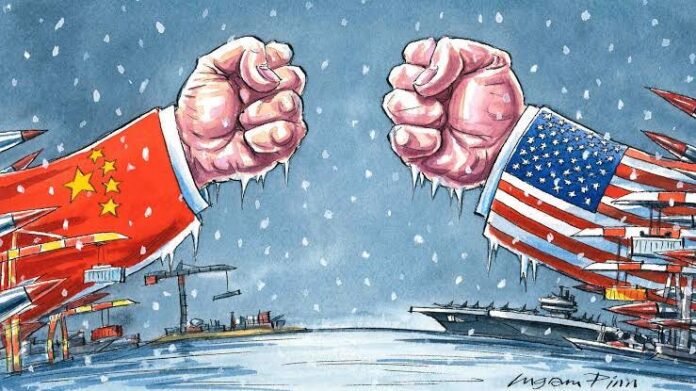Author: Avery Goldstein
Affiliation: Political Science Department, University of Pennsylvania, Philadelphia, PA, USA
Organization/Publisher: China International Strategy Review
Date/Place: June, 2020
Type of Literature: Journal Article
Number of Pages: 15
Link: https://doi.org/10.1007/s42533-020-00036-w
Keywords: Cold war, China, United States, Bipolarity, Nuclear Deterrence, Anarchy, Cyber-attacks
Brief:
The fluctuation of US-China relations over the past twenty-five centuries has significantly deteriorated since 2019, with a potential for direct confrontation. This development has sparked a debate on the emergence of a second Cold War. In this study, the author investigates five fundamental factors contributing to the growing confrontation between the US and China in the twenty-first century. These factors include the structural conditions of anarchy, the transformation of polarity in the international system, geographical constraints, nuclear implications, and the emergence of new cyber technologies as weapons. By examining these factors, attention is drawn to comparisons and contrasts between the US-China rivalry and the old Soviet-American rivalry during the Cold War.
The situation of anarchy, which reflects the structural condition of the international system, has different implications for the US-Soviet experience compared to the new US-China rivalry, particularly in economic relations. While the US and the Soviet Union were completely isolated during the Cold War, each with its own economic bloc and security alliance, this is not the case with Washington and Beijing. In contrast, since the end of the Cold War, the US and China have had a prominent economic interdependence, especially due to Washington’s policy of rapprochement and Beijing’s “reform and opening up” policies. However, as the rivalry between the two nations emerged and intensified in the twenty-first century, each side began to worry about their interdependencies and focused more on their relative gains. Many American observers criticized US policymakers, stating that their policy of engagement had inadvertently helped China become richer and stronger, thus posing a challenge to American power and potentially threatening American security. In the 2010s, the decline in US-China economic interdependence became more evident, leading to what is now known as decoupling. The author argues that decoupling is an incredibly disruptive process that will require significant adaptations from both countries and will undoubtedly impact the global economy. Moreover, the process of decoupling will reinforce security apprehensions caused by disorder, as each party becomes acutely aware of the various vulnerabilities generated by their interdependence.
The rise of China as a great power in the international system has accelerated the transition away from US post-Cold War unipolarity. As the twenty-first century approaches, the emergence of bipolarity has caused China and the US to react to its limitations in a manner similar to how the Soviet Union and the US behaved in the previous century. For example, Washington has been vocal about China’s increasing global economic influence and its growing military presence in various regions, ranging from Africa to the Arctic, albeit still limited. On the other hand, Beijing argues that American panic unjustly impairs China’s goodwill in playing a beneficial role in global management and assuming global responsibilities in line with its expanding capabilities.
While anarchy and bipolarity represent the structural constraints of the US-China rivalry, the geographic setting can be considered as a national attribute that highlights a sharp contrast between the Cold War and the current rivalry. In this regard, the European continent served as the main theater for the US-Soviet rivalry, whereas the US-China rivalry has unfolded in the waters of the western Pacific Ocean. The author asserts that these geographical settings present two important contrasts. First, the Pacific theater lacks a clear division based on each party’s easily comprehensible vital interests, and the two countries have not experienced the types of hazardous and sobering events that characterized the behavior of the Soviet Union and the US during the Cold War in Europe. Second, the maritime domain possesses distinctive dangers compared to the land-based military positioning of the Cold War in Europe.
Similarly to the Cold War, the rivalry between the US and China is also shaped by a nuclear arms race. During the Cold War, the bipolar nature of the international system led to a wasteful nuclear weapon build-up by the Soviet Union and the US. However, this practice has not been fully echoed in the current US-China rivalry. Nonetheless, the author suggests that this difference may not persist for much longer.
Another distinctive attribute of the current US-China rivalry is the competition in the realm of new technology, particularly the emergence of cybertechnologies with potentially worrisome military implications. The author highlights two major concerns regarding the fusion of cybertechnology and military capability. First, the combination of network and weapons is vulnerable to the threat of network disruption by the enemy, which raises the stakes for preemptive action rather than promoting self-control, patience, crisis management, and tension reduction. Second, the contemplation of cyber warfare seems to be a driving force behind the potential escalation of an arms race between the United States and China in the deployment of conventional weapons. Furthermore, both countries would have motivations to construct progressively larger conventional military stockpiles for direct utilization of physical power.
In conclusion, the author suggests that the rivalry between the US and China will not be an exact replica of the Cold War in the 20th century. Currently, and possibly in the future, it is not characterized by a worldwide ideological struggle, complete economic disconnection, or military rivalry through proxy wars as seen during the Soviet-American Cold War.
By: Salman Nugraha, CIGA Research Intern




